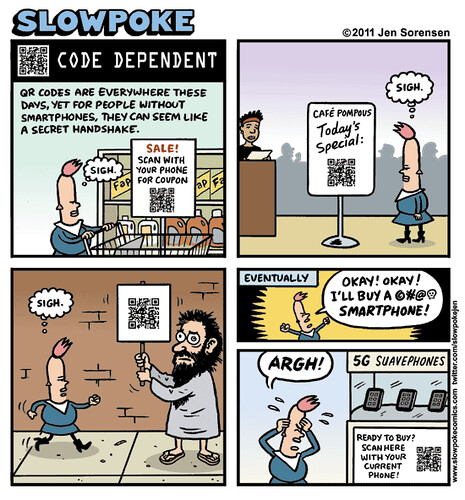Information production vs. consumption and digital access

Slowpoke comic, Jan Sorenson.
My home office computer has some software flaw at the moment, so I can't reply to comments in the comments on entries. In the previous entry, Spookiness writes:
This is good PR I suppose, but most trends I have seen seem to point to the decline of home PC's connected to fixed wireline broadband connections. More and more, it's simply not the way that most people are connecting to the internet nowadays. Even poor people have cell phones with smart phone capability and internet access that way. This seems about 10 or 15 years too late, and frankly like the "food desert" issue, I think the digital divide is overstated.
I am not absolutely opposed to your argument about the digital divide. Research from many years ago by Milton Mueller (now at Syracuse) found that lower income households spent plenty of money on telecommunications services such as cable and cell phones, just not computer-related services. (Mueller M. and Schement, J. R. "Universal Service from the Bottom Up: A Profile of Telecommunications Access in Camden, New Jersey." The Information Society 12:3 (August 1996).
However, I don't necessarily agree with your argument in terms of what we might call digital access devices and Internet connection.
Maybe you can write a paper or produce a digital media production on a phone, but I think it would be almost impossible.
E.g., someone like myself, who writes, finds micro-devices like smartphones extremely frustrating, because they aren't designed for serious writing or research. Maybe an Ipad can get you there as opposed to a phone, I haven't used one in depth. I won't write a blog entry on a phone. It takes too damn long.
This data is from an article in Municipal World (the Canadian public administration monthly magazine) from a few years ago, the basic point is that more than half the people "on the Internet" consume content but don't produce it. The numbers total more than 100%.
info seekers 51%
spectators 33%
joiners 19%
info sharers 15%
critics 19%
creators 13%
Creators are screwed by limitations on the ability to create. That's why people like me need computers, be they hardwired or not, because we write or otherwise develop and produce "content." I can't write on an smartphone, even if I can use it to consume content.
I think students in particular probably need more traditional "digital access devices," in other words, "computers" (laptops/Ipads qualify) first, and internet connections second. A computer matters. Whether or not the connection is landline or wireless matters less.
Labels: digital/Internet, knowledge management, media and communications, public education/K-12, social exclusion



0 Comments:
Post a Comment
<< Home